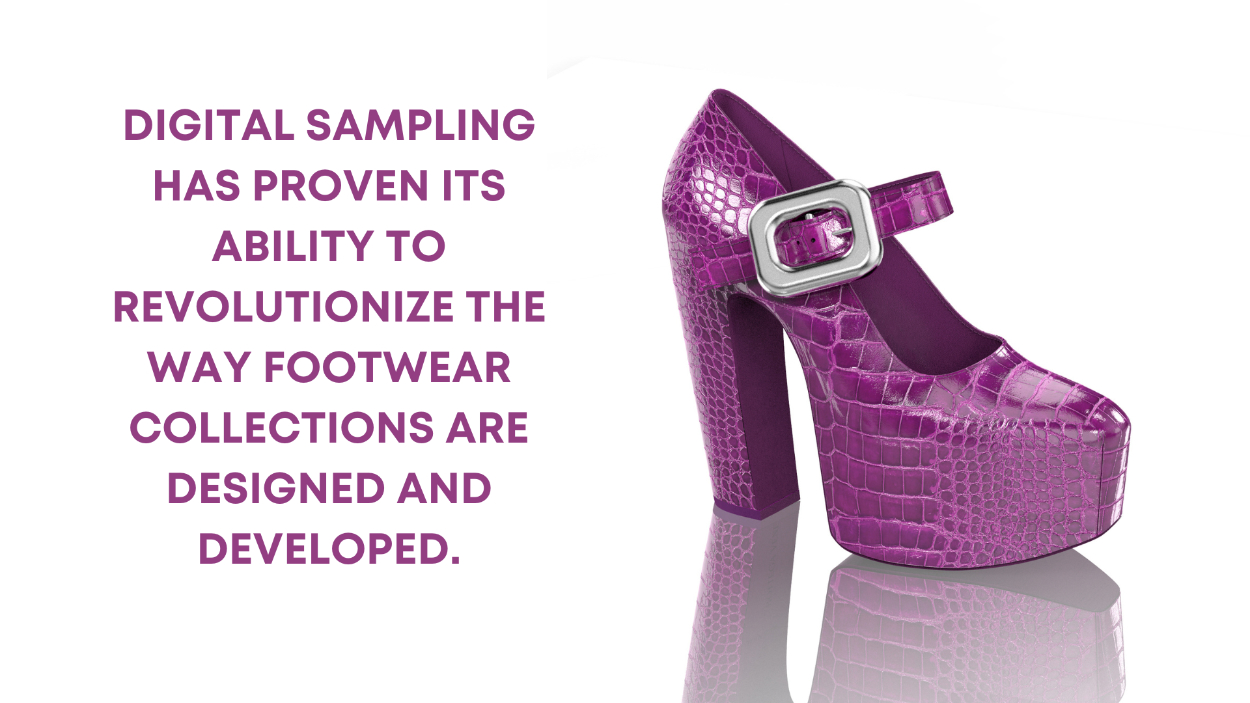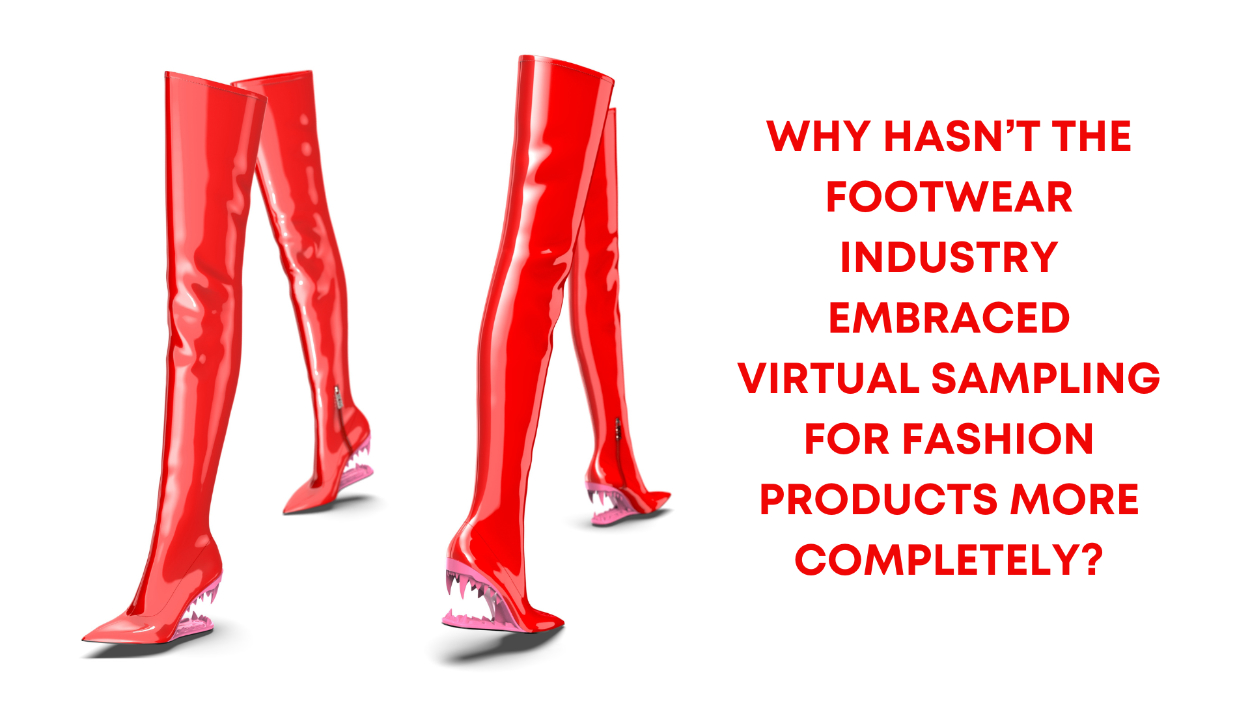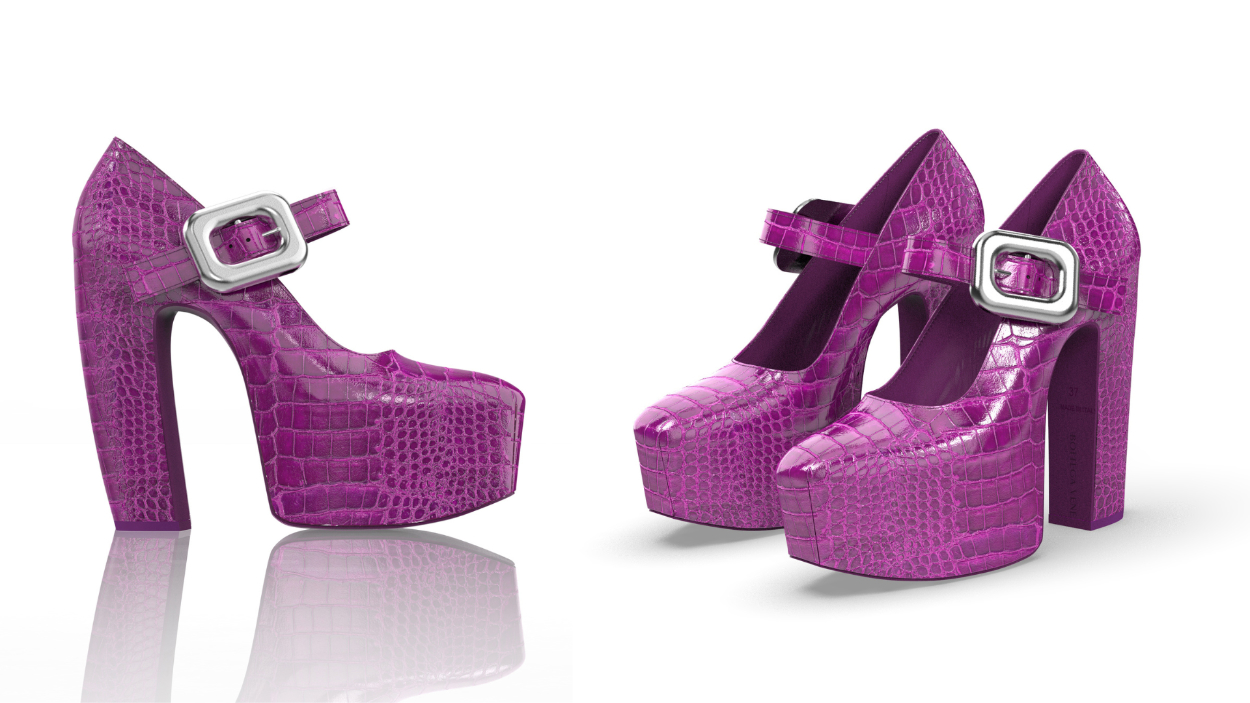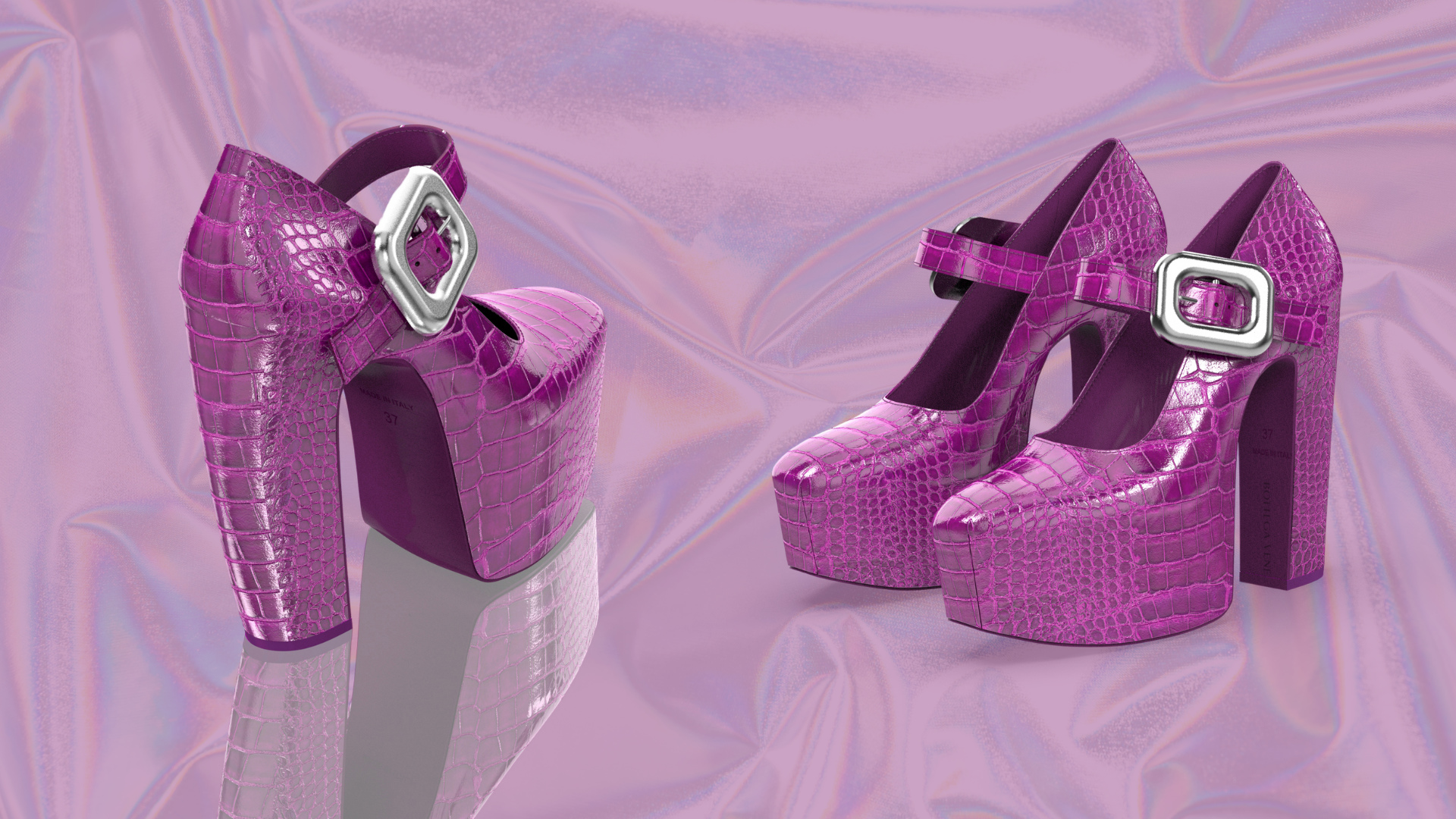[Featured image: DUO Design Studio]
This article was originally published in The Interline’s DPC Report 2024. To read other opinion pieces, exclusive editorials, and detailed profiles and interviews with key vendors, download the full DPC Report 2024 completely free of charge and ungated.
Key Takeaways:
- The fashion footwear industry produces approximately 14 billion pairs of shoes annually, requiring an average of 13 samples per shoe design. This leads to millions of wasted samples and significant environmental impact through material waste, water consumption, and carbon emissions from shipping.
- Digital sampling offers multiple benefits beyond sustainability, including reduced development timelines, lower production costs (up to 60% savings), and expanded opportunities in e-commerce and marketing through virtual showrooms, AR try-ons, and digital content creation.
Every year, the fashion footwear industry produces an estimated 14 billion1 pairs of shoes—and generates millions of wasted samples in the process. Despite this staggering environmental cost, the design and development lifecycle of fashion footwear – which we define as being footwear designed for fashion purposes rather than athletic or outdoor performance – has remained largely unchanged for the past two decades, even as technical and process innovation has changed how engineering and platform development operates.
As a result, other sectors of the footwear industry, such as performance footwear, have been able to position themselves at the forefront of innovation where 3D and DPC are concerned, fashion footwear has fallen behind the curve, relying on outdated practices. These inefficient systems exacerbate material waste, water consumption, and carbon emissions – all of which are variables that the sector is either already being held to account for in line with sustainability regulations, or will soon be.

The tools to modernise, though, have been available for years. Digital sampling, in particular, has proven its ability to revolutionize the way footwear collections are designed and developed. It offers the potential to drastically reduce waste, streamline processes, and drive profitability. Yet, despite its longstanding presence in the industry (virtual sampling has become so synonymous with 3D that other sectors see it as something approaching table stake), many footwear brands continue to resist fully integrating virtual methods into their workflows, relying instead on traditional practices that are increasingly misaligned with the demands of a sustainable and efficient future – all in the name of designers and merchandising and sales teams feeling the need to continue touching physical samples before making any concrete decisions.
Sustainability is no longer optional. Fashion footwear needs to keep pace.
To meet the global demand for footwear, around 26 million1 physical samples are created annually. On average, 13 samples are required to finalize just one shoe, with most of these having no practical end use, resulting in significant waste. By integrating digital samples into the development process, brands can reduce their reliance on physical samples in unnecessary areas such as colourway changes, simple material swaps, and other iterations that take place on top of already-proven platforms. These re-colours and material swaps can, at the scale the industry conducts them, account for a quarter or even half of a fashion footwear collection – and every re-detail currently requires its own physical sample.
As well as the impact of creating those samples (which is measured in time, cost, materials and resources) currently, physical samples are often shipped in sets to multiple different locations so that team members—both domestic and international—can review them. This system comes at a tremendous environmental cost. Flights alone emit an estimated 397 billion2 tons of CO₂ annually from shipping, with additional emissions generated through ground transport.
Digital sampling has the potential to cut these flights, dramatically reducing the industry’s carbon footprint. Beyond emissions, the pre-production process consumes substantial material and water resources, further amplifying the environmental toll. The cost to our planet is undeniable, and digital solutions offer a clear pathway to a more sustainable future.
This is, as we have already seen, one of the key levers that other product categories have already used to justify investment in 3D, as well as one of the most important metrics that have been used to judge the return on that investment – having both an environmental and a pronounced efficiency effect.
Digital sampling leads to digital transformation – provided trust is in place.
More than just addressing the planetary impact, by integrating digital sampling, footwear brands have the chance to significantly reduce development timelines and respond more effectively to evolving market dynamics – providing their teams are able to build trust in digital assets, and provided cultural transformation, and a willingness to challenge established product timelines, are allowed to take root. In an industry where products are often finalized nearly a year before reaching consumers, this approach can help fuel agility, and shorten the window between a trend and a finished product – allowing brands to incorporate near-time market data and consumer analytics to design collections that are both precise and profitable.

A recent McKinsey report identified reducing speed to market as one of the top three strategic priorities for 55%3 of companies, alongside improving demand forecasting and increasing digital presence—objectives that digital sampling directly addresses. By optimizing workflows and ensuring designs are closely aligned with consumer needs, digital sampling positions brands to remain competitive in a fast-paced, data-driven marketplace.
Overcoming resistance through extended use cases
So, with all this potential stacked on one side of the equation, why hasn’t the footwear industry embraced virtual sampling for fashion products more completely? The simplest answer is inertia: industry leaders feel secure in the traditional process of reviewing collections by physically touching and holding samples—a sense of familiarity and control that has defined the operations of leading brands for decades. And for many of those brands – especially in the sneaker sector – the last few years have been some of their most profitable in a long time. Why change a system that, from an internal vantage point at least, is working?
Developers also raise concerns about transitioning factories to digital workflows, reasoning that if designers are creating in 3D but manufacturers are not set up the same way, then can digital samples actually shorten the average footwear lifecycle? While these objections are often valid, the footwear industry is seeing a similar push to the apparel industry, where brands, manufacturers, and their technology partners are working to more tightly integrate 3D modelling and 2D pattern drafting to try and ensure that the design-to-production process flows more seamlessly.
But to help overcome some of that inertia, it will be important for footwear brands to realise the potential benefits of virtual samples and 3D representations of that extend beyond the design phase, and into omnichannel e-commerce and marketing – where they can stand in for physical samples and physical products in a range of applications.
E-commerce
- Photorealistic Visuals: Digital samples enable the creation of high-resolution product photography, including 360° views, eliminating the need for physical photo and model samples. Many brands currently order up to six pairs of physical samples for these purposes—a significant waste that digital sampling can eliminate.
- Pre-Orders and Demand Forecasting: With digital samples, brands can launch pre-order campaigns to gauge consumer demand before committing to production, reducing waste and aligning inventory with market needs. Brands can also tease products on social media using digital visuals to analyze consumer interest and refine designs before launch.
- Virtual Try-On Tools: AR-powered virtual try-on tools build consumer confidence, reduce purchase barriers, and significantly boost conversion rates. While this innovation is often associated with performance footwear, it’s time for the fashion footwear sector to embrace this technology to connect with tech-savvy, digital-native consumers.

Marketing
- Dynamic Digital Content: Brands like Jacquemus have leveraged 3D digital content to create iconic and innovative campaigns, showcasing a fresh, creative side of their identity. These efforts foster deeper consumer connections and position the brand as forward-thinking.
- Virtual Showrooms: Brands like Diesel are using virtual showrooms to present their collections, offering immersive and accessible experiences that increase customer reach. These digital spaces allow brands to engage with their online communities meaningfully, fostering a sense of connection and belonging.
As consumers increasingly expect brands to build authentic online communities, it’s proving critical for companies to invest in their digital presence – something that can be done as a corollary benefit of creating digital twins of physical products to streamline their design, development, sampling, and production phases
Conclusion: the future is digital
The fashion footwear industry is at a pivotal moment. The environmental, economic, and operational challenges of traditional pre-production processes have always been unsustainable, but now the increasing pressures of production costs, tariffs, and economic uncertainty have created an urgent need for cost-saving strategies. As development expenses climb, footwear brands are striving to maintain competitive pricing while protecting their margins. Digital sampling presents a compelling solution, cutting both sample production and shipping costs by over 60%1 at the same time as working to minimise waste and reduce environmental impact.
SOURCES
- DUO Design Studio. DUO Design Studio is currently collaborating with Colorado State University to expand on and publish these findings
- MIT.edu, DUO Design Studio. DUO Design Studio is currently collaborating with Colorado State University to expand on and publish these findings. Based upon the average annual design cycle of 4 seasons per year, 50 styles per season, 3 SKUs per style
- McKinsey & Co
